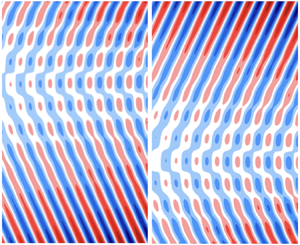No CrossRef data available.
Article contents
One-winged butterflies: mode selection for azimuthal magnetorotational instability by thermal convection
Published online by Cambridge University Press: 27 August 2024
Abstract

The effects of thermal convection on turbulence in accretion discs, and particularly its interplay with the magnetorotational instability (MRI), are of significant astrophysical interest. Despite extensive theoretical and numerical studies, such an interplay has not been explored experimentally. We conduct linear analysis of the azimuthal version of MRI (AMRI) in the presence of thermal convection and compare the results with our experimental data published before. We show that the critical Hartmann number ( $Ha$) for the onset of AMRI is reduced by convection. Importantly, convection breaks symmetry between
$Ha$) for the onset of AMRI is reduced by convection. Importantly, convection breaks symmetry between  $m = \pm 1$ instability modes (
$m = \pm 1$ instability modes ( $m$ is the azimuthal wavenumber). This preference for one mode over the other makes the AMRI wave appear as a ‘one-winged butterfly’.
$m$ is the azimuthal wavenumber). This preference for one mode over the other makes the AMRI wave appear as a ‘one-winged butterfly’.
- Type
- JFM Rapids
- Information
- Copyright
- © The Author(s), 2024. Published by Cambridge University Press





